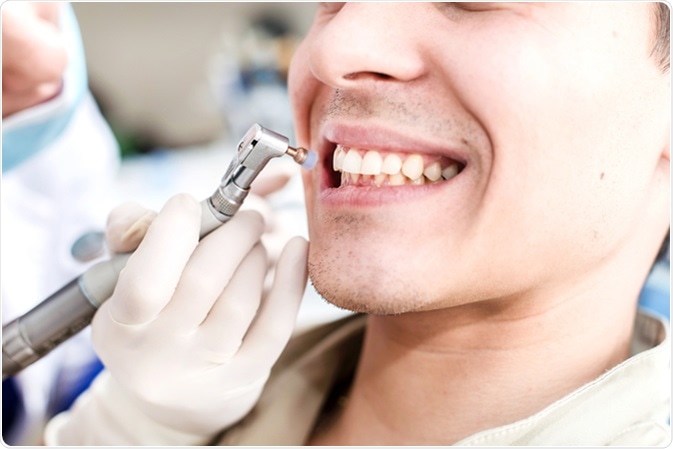Tooth Polishing Procedure

Tooth polishing is a dental procedure, which is used for the prevention of teeth problems. It also makes teeth appear whiter, stain-free, and glistening. This procedure improves dental health and aesthetics of the teeth.

Objectives of Tooth Polishing
Earlier, tooth polishing was routinely done as a part of dental prophylaxis. However, soon it was realized that the overuse of this technique erodes outermost covering of the tooth structure. The loss of the outer structure makes teeth more vulnerable to stains and plaque accumulation. Also, repetitive use of this procedure removes the protective fluoride layer surrounding the teeth.
These days, dentists do not recommend tooth polishing as a routine dental procedure, and a careful case selection is done prior to this procedure.
Advantages of Tooth Polishing
Tooth polishing is a procedure which not only polishes the teeth but also removes the dental stains, plaque, and microorganisms formed on the outer surface of the teeth.
The main advantage of tooth polishing over the tooth scaling (deep cleaning of the teeth) is that it is a painless procedure. Also, patients experience clean and smooth teeth instantaneously after the procedure.
Types of Tooth Polishing
- Therapeutic polishing – Many a times during a dental surgical procedure, the cementum covering the root is exposed. Therapeutic polishing assists in the removal of any microflora and endotoxins from the surface of cementum.
- Coronal / cosmetic polishing – This type of polishing removes the plaque and superficial dental stains. Superfine abrasive agents are used to make the enamel (outer layer covering the crown of the tooth) lustrous. Enamel surface is polished to an extent that it can even reflect the visible light.
- Superficial polishing – This technique polishes the crown of the tooth. However, this technique has nominal curative benefits, and is primarily done to improve the aesthetic appearance of the teeth.
- Selective polishing – Selective polishing is also termed as extrinsic stain removal or selective stain removal. This polishing technique is recommended post scaling procedure, and it removes any remaining stains.
Which type of Stains Tooth Polishing Can Remove?
There are two types of dental stains – endogenous and exogenous. Endogenous stains are internal stains which are caused due to certain dental defects such as developmental or drug-induced enamel hypoplasia. Exogenous stains are external stains, which arise due to poor dental habits and smoking.
Tooth polishing is beneficial in removing only the exogenous stains, and cannot remove the internal or endogenous stains.
Points to Remember at the Time of Tooth Polishing
- A correct technique should be employed during the procedure to minimize the abrasion on the tooth surface
- Less abrasive polishing agent should be used
- Pressure, speed of the polishing device, and time taken for the procedure should be carefully monitored
Application of the Prophylaxis Paste
Prophylaxis paste is applied on the area of the tooth surface which requires polishing. Some pastes having bigger particle sizes are more potent in removing the external stains and plaque. Some of the dental practitioners prefer using these pastes as they remove the dental stains easily and quickly. However, these pastes have a high abrasive strength, and can lead to the loss of the tooth structure.
Prophylaxis pastes which have smaller particle sizes make the tooth surface cleaner, lustrous, and smooth. These pastes also make the tooth surface less prone to plaque and stain accumulation. However, polishing with these pastes is a laborious and a time-consuming procedure.
Some key factors which make tooth polishing more effective are as below:
- Rotations per minute of the polishing device such as rubber cup
- Pressure at which the rubber cup is applied on the tooth surface during polishing
- Coarseness of the prophylaxis paste
- Time taken for the procedure
Tooth polishing should initially be performed with coarse abrasion, and then should be followed by fine abrasion. This gradual shift from coarser to finer abrasion results in scratches lesser than 0.5 mcm in size. These scratches have a diameter lesser than the wavelength of the visible light, thereby making the tooth surface appear more shiny and lustrous.
However, the abrasive agent should be carefully selected as the hardness of the abrasive agent should not exceed the hardness of the surface to be polished.
Tooth Polishing Instruments
Tooth polishing instruments are both manual and engine-driven. Manual polishers are used by the dentists to manually polish the tooth surface with the help of their hands, whereas engine-driven polishing instruments require handpieces. Tooth polishing is usually performed with the help of mechanical device and a polishing agent.
Hand-held polishing instruments include:
- Porte polisher
- Polishing strips
Engine-driven instruments are:
- Rubber cups
- Air-powder polisher
Vector System
This technique uses the polishing fluids to polish the tooth surfaces. This technique has an advantage over the other methods as it causes minimal or no damage to the tooth structure. Hydroxyapatite polishing fluid and silicon carbide abrasive fluid are used to polish the tooth surface by this technique.
Sources:
- https://www.ncbi.nlm.nih.gov/pmc/articles/PMC4555792/
- www.dentistryiq.com/…/…ontraindications-for-dental-assistants.html
- www.corsodyl.co.uk/caring-for-your-gums/what-is-a-scale-and-polish/
- odha.on.ca/wp-content/uploads/2016/08/FINAL-Tooth-Polishing.v3.pdf
- www.rdhmag.com/…/Binder1.pdf
- https://statelinedental.com/step-by-step-teeth-cleaning-process/
Further Reading
- All Teeth Content
- Dental Health in Children
- Foods Good for Teeth
- When Should Children Get Their Adult Teeth?
- Why Don’t All Wisdom Teeth Descend in Adults?
Last Updated: Aug 23, 2018

Written by
Akshima Sahi
Akshima is a registered dentist and seasoned medical writer from Dharamshala, India. Akshima is actively involved in educating people about the importance of good dental health. She examines patients and lends free counseling sessions. Taking her passion for medical writing ahead, her aim is to educate the masses about the value of good oral health.
Source: Read Full Article